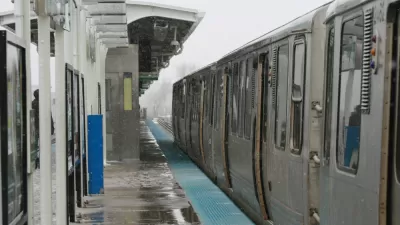Subsurface heat islands in dense urban areas can cause buildings and infrastructure to shift, tilt, and crack, a new study finds.

A novel study by Northwestern University in Chicago says there is a “silent hazard beneath the streets” that could have a major impact on buildings and infrastructure in the future: “underground climate change.” A Financial Times article by Patti Waldmeir details the findings and what it could mean for Chicago and other cities around the world.
The Northwestern research team, headed up by researcher Alessandro Rotta Loria, were the first to study how these subsurface heat islands that deform the ground affect urban infrastructure, Waldmeir reports. They placed underground sensors throughout the Chicago Loop and found the ground beneath some buildings can be 18F hotter than underneath a large park along the lake nearby. The effect is caused by heat emitted into the ground by underground structures (garages, basements, El tunnels, etc.) which causes the ground to expand and contract.
While these subsurface heat items aren’t likely to cause buildings to collapse or kill anyone, in the long-term, Rotta Loria said, it could mean shifting, tilting, and cracking buildings and infrastructure, which lead to significantly higher repair and maintenance costs, particularly in cities built near water.
FULL STORY: Sinking skyscrapers, new beaches: Chicago faces the climate crisis

Trump Administration Could Effectively End Housing Voucher Program
Federal officials are eyeing major cuts to the Section 8 program that helps millions of low-income households pay rent.

Planetizen Federal Action Tracker
A weekly monitor of how Trump’s orders and actions are impacting planners and planning in America.

Ken Jennings Launches Transit Web Series
The Jeopardy champ wants you to ride public transit.

Rebuilding Smarter: How LA County Is Guiding Fire-Ravaged Communities Toward Resilience
Los Angeles County is leading a coordinated effort to help fire-impacted communities rebuild with resilience by providing recovery resources, promoting fire-wise design, and aligning reconstruction with broader sustainability and climate goals.

When Borders Blur: Regional Collaboration in Action
As regional challenges outgrow city boundaries, “When Borders Blur” explores how cross-jurisdictional collaboration can drive smarter, more resilient urban planning, sharing real-world lessons from thriving partnerships across North America.

Philadelphia Is Expanding its Network of Roundabouts
Roundabouts are widely shown to decrease traffic speed, reduce congestion, and improve efficiency.
Urban Design for Planners 1: Software Tools
This six-course series explores essential urban design concepts using open source software and equips planners with the tools they need to participate fully in the urban design process.
Planning for Universal Design
Learn the tools for implementing Universal Design in planning regulations.
Ada County Highway District
Clanton & Associates, Inc.
Jessamine County Fiscal Court
Institute for Housing and Urban Development Studies (IHS)
City of Grandview
Harvard GSD Executive Education
Toledo-Lucas County Plan Commissions
Salt Lake City
NYU Wagner Graduate School of Public Service





























